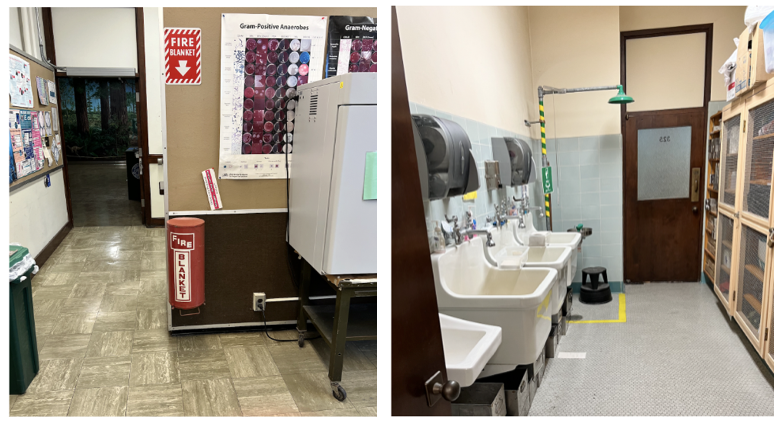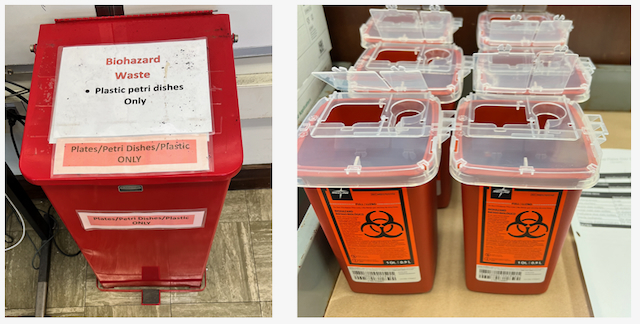1: Introduction to the Microbiology Laboratory
- Page ID
- 110761
\( \newcommand{\vecs}[1]{\overset { \scriptstyle \rightharpoonup} {\mathbf{#1}} } \)
\( \newcommand{\vecd}[1]{\overset{-\!-\!\rightharpoonup}{\vphantom{a}\smash {#1}}} \)
\( \newcommand{\id}{\mathrm{id}}\) \( \newcommand{\Span}{\mathrm{span}}\)
( \newcommand{\kernel}{\mathrm{null}\,}\) \( \newcommand{\range}{\mathrm{range}\,}\)
\( \newcommand{\RealPart}{\mathrm{Re}}\) \( \newcommand{\ImaginaryPart}{\mathrm{Im}}\)
\( \newcommand{\Argument}{\mathrm{Arg}}\) \( \newcommand{\norm}[1]{\| #1 \|}\)
\( \newcommand{\inner}[2]{\langle #1, #2 \rangle}\)
\( \newcommand{\Span}{\mathrm{span}}\)
\( \newcommand{\id}{\mathrm{id}}\)
\( \newcommand{\Span}{\mathrm{span}}\)
\( \newcommand{\kernel}{\mathrm{null}\,}\)
\( \newcommand{\range}{\mathrm{range}\,}\)
\( \newcommand{\RealPart}{\mathrm{Re}}\)
\( \newcommand{\ImaginaryPart}{\mathrm{Im}}\)
\( \newcommand{\Argument}{\mathrm{Arg}}\)
\( \newcommand{\norm}[1]{\| #1 \|}\)
\( \newcommand{\inner}[2]{\langle #1, #2 \rangle}\)
\( \newcommand{\Span}{\mathrm{span}}\) \( \newcommand{\AA}{\unicode[.8,0]{x212B}}\)
\( \newcommand{\vectorA}[1]{\vec{#1}} % arrow\)
\( \newcommand{\vectorAt}[1]{\vec{\text{#1}}} % arrow\)
\( \newcommand{\vectorB}[1]{\overset { \scriptstyle \rightharpoonup} {\mathbf{#1}} } \)
\( \newcommand{\vectorC}[1]{\textbf{#1}} \)
\( \newcommand{\vectorD}[1]{\overrightarrow{#1}} \)
\( \newcommand{\vectorDt}[1]{\overrightarrow{\text{#1}}} \)
\( \newcommand{\vectE}[1]{\overset{-\!-\!\rightharpoonup}{\vphantom{a}\smash{\mathbf {#1}}}} \)
\( \newcommand{\vecs}[1]{\overset { \scriptstyle \rightharpoonup} {\mathbf{#1}} } \)
\( \newcommand{\vecd}[1]{\overset{-\!-\!\rightharpoonup}{\vphantom{a}\smash {#1}}} \)
By the end of this lab period, you will be able to
- Articulate appropriate safety procedures in the microbiology lab.
- Wash your hands and disinfect lab surfaces correctly
- Identify the correct ways to dispose of lab waste (compost, biohazard, used slides, culture tubes with media, Petri dishes).
- Identify which supplies you need to purchase and bring to the next laboratory period
- Explain why most professional healthcare programs require an in-person microbiology laboratory experience.
Introduction
Welcome to the microbiology laboratory! We are delighted to have you in our classes and excited to share our passion for microorganisms with you. The microbiology laboratory will give you the opportunity to develop new skills, apply critical thinking to solve problems and work independently on a multi-week project culminating in a written report.
Today we will be reviewing basic microbiology lab safety, and waste disposal methods. We will also determine which supplies you will need to purchase and assign lockers. We often have lab coats that we can loan to students for the duration of the semester.
Be prepared to be quizzed on the content of today’s laboratory lecture, particularly the safety rules.
General Lab Safety
- Read all laboratory material before coming to class. The most important thing you can do to be safe in the lab is to be prepared and know in advance what you will be doing and why!
- Familiarize yourself with emergency exits, the eyewash station, the fire blanket and extinguisher, the first aid kit, and the broken glass container (Figure \(\PageIndex{1}\))

- Wear a lab coat whenever working with microbes. You should bring your lab coat home to wash regularly (it’s a good idea to wash the coat in hot water with a little bleach).
- You must wear closed-toed shoes in the lab at all times - even if lab work is not scheduled on that day. Glassware is routinely broken in labs, and laboratory floors are not a safe place for flip-flops or strappy sandals. For your safety, the instructor will ask you to go home and return with appropriate footwear if necessary.
- Wear disposable gloves when working with microbes, and when staining microbes for viewing under the microscope. The biological stains we use will remain on your fingers for days…and they will ruin your nice shoes or clothes.
- Turn off the Bunsen burners whenever you are not working with them!
- Notify the instructor if you are pregnant, or become pregnant or have any other medical conditions that might necessitate special precautions.
- Long hair should be tied back when working in the laboratory.
- No optional or original experiments are to be conducted without prior approval.
- Do not taste any chemicals.
- Do not pour unused chemicals back into the stock bottle.
- Broken glass should be reported to the instructor who will assist you in the immediate cleanup. Broken glass is to be discarded only in a “broken glass” container.
- Place plastic Petri dishes, disposable plastic Pasteur pipettes, and other non-sharp disposable items contaminated by bacteria, blood, or body fluids in a disposable autoclave bag for decontamination by autoclaving or place them directly into a 10% bleach solution before reuse or disposal.
- Wash the laboratory table surface after you have finished the activity when applicable.
- Sanitize benches BEFORE and AFTER lab. Leave the disinfectant solution on the bench to air dry.
- Dispose of any trash or chemicals properly.
- Clean all equipment and return it to the storage area before leaving the laboratory work area.
- Report any spill, accident, or injury to the instructor immediately, and follow emergency procedures as necessary.
- Do not sit on lab benches in Microbiology!!! Ewwww….
- When staining bacteria or using any chemicals, wear safety goggles.
- Place backpacks and purses out of high-traffic areas!
- If you are not sure of something.....ask for help or clarification before you start!!
Protecting yourself, your lab partners, and your cultures from accidental contamination
- Wipe the desktop with the disinfectant (red squirt bottles) before and after each lab period. Never assume that the class before you disinfected the work area. Allow the disinfectant to evaporate; do not wipe it dry.
- Never lay culture tubes on the table; they always should remain upright in a culture tube rack.
- Report any spills of bacterial cultures immediately to your instructor, and request instructions. In general, cover any large culture spills with paper towels. Soak the towels immediately with disinfectant and allow them to stand for 20 minutes. When you are finished, place the towels in the red biohazard bin.
- If the culture spills on you, let your instructor know and they will help you (this is why you wear a lab coat!).
- If you get a microbial culture in your eyes IMMEDIATELY have a lab partner lead you to the eyewash and rinse your eyes for at least 15 minutes. Speed is important to prevent injury to the eye. Notify your instructor of the spill and your situation, and follow their instructions for handling your care and the spill.
- Take care with computers, phones, and other items that you place on the lab bench. Ensure they remain a safe distance from bacterial cultures and do not become contaminated. We do use and need our computers in the lab on a regular basis.
Safe Disposal of Trash, Contaminated Items, and Glass
In the CCSF Microbiology Lab, we separate waste into various categories.
- Paper towels that are not contaminated with bacteria are disposed of in the green bins - they are compostable. It is okay to throw away paper towels with dye or sanitizing solution on them. (Figure \(\PageIndex{2}\))
- Gloves and non-recyclable trash can go in the grey trash bins. (Figure \(\PageIndex{2}\))

- Contaminated materials (blood, bacteria, body fluids) that are not sharp like gloves, paper towels, plastic Petri dishes, and cotton swabs, go in a biohazard bag. (Figure \(\PageIndex{3}\))
- Sharp objects like needles must be disposed of in a designated sharps container. (Figure \(\PageIndex{3}\))

- Remove all labels from glass culture tubes using alcohol/acetone and a cotton ball. Place them upright in the designated autoclave container. (Figure \(\PageIndex{4}\))
- Notify the instructor of any broken glass. We use a lot of glass tubes, and glass does occasionally break. Your instructor is the person designated to safely dispose of broken glass. Do not touch or clean up broken glass on your own.
Biosafety Levels
Infectious agents (microorganisms) are divided into four main biosafety levels - BSL-1, BSL-2, BSL-3, and BSL-4. BSL-1 organisms are not known to cause disease in healthy adults. BSL-2 agents are associated with some human diseases, but treatments/vaccines are usually available. BSL-3 and BSL-4 organisms are more exotic and dangerous and require special facilities in order to be safely manipulated.
At City College of San Francisco, we work with BSL-1 and BSL-2 organisms only. Most of our organisms do not typically cause disease in healthy individuals and present a minimal threat to the environment and lab personnel. These include organisms such as Escherichia coli (the strains we use), Bacillus subtilis, and Lactococcus lactis - all of which are BSL-1.
BSL-2 organisms are commonly encountered in the community and present a moderate environmental and/or health hazard. These organisms are associated with a variety of human diseases, most of which can be successfully treated if identified in a timely manner. The infection routes of primary concern are ingestion, inhalation, or penetration of the skin (percutaneous). We do not work with these organisms in a way that results in splashes or aerosol generation (even though these organisms are not generally known to be transmitted by aerosols). Therefore laboratory work in BIO 120 may be done using standard microbiological practices. BSL-2 organisms that we encounter in BIO 120 include organisms such as Salmonella enterica and Staphylococcus aureus.
Learn about Biosafety Levels by completing this very short tutorial which was developed by the Centers for Disease Control and Prevention.
Materials
You must have these by Week 2. You may share some of these with a lab partner to save on costs.
- A long-sleeved shirt or lab coat that covers you below the waist. Color unimportant.
- Nitrile or latex gloves (make sure that you are not allergic to latex)
- Hair ties for long hair
- Rubber bands
- Colored pencils or pens (include purple, pink, red, green & blue)
- A sharpie (thick point) permanent marker or wax pencil
- Box of microscope slides (one box per student)
- A blue box for holding microscope slides (CCSF Bookstore)
- Lens and blotting (bibulous) paper
- Lab Safety Goggles

